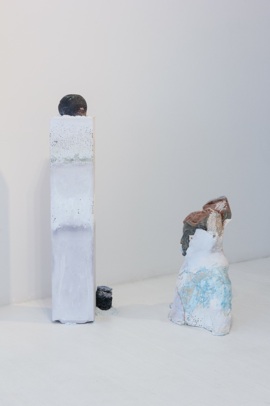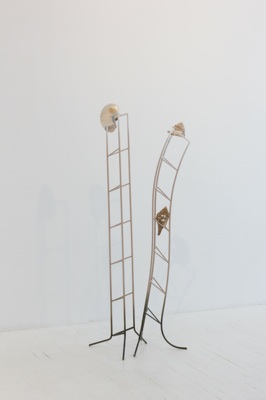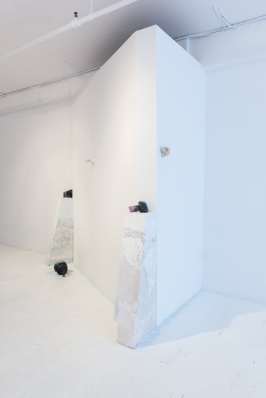The Fourth Kingdom
- Maude BERNIER CHABOT
Urban legend: In a contemporary art museum, a visitor is moved to tears while spending an hour gazing at a wall under construction, thinking he/she is looking at a masterpiece. The embarrassed security guard dares not say anything about the actual nature of the contemplated heap of concrete blocks. If this story refers to the supposed formal ‘anything goes’ regarding contemporary art, it touches on a sensitive nerve: the status of the art object that is distinct from other categories of objects. The works Maude Bernier Chabot presents in The Fourth Kingdom at CIRCA art actuel seem influenced by this kind of thought, a potential approach to her complex, refined artworks.
During a studio visit to see the new work she created for Circa, Maude Bernier Chabot welcomed me at the door of the building, and asked me to help her carry up an aluminum half sphere, something midway between a giant wok and a flying saucer. This object, cast in plaster and polyacrylate, is to be both a finished work and a device to modify the space. This first level of complexity, concerning the role of the object, complements a second level linked to the origin of the latter. In her pieces, Maude assembles found objects with created objects so viewers are unable to easily distinguish their true origin. Finally, a third level pertains to the category of elements, since she uses many remnants from the animal world, industrial products and, of course, objects entirely created in the studio. Far from being a superficial gesture, this decompartmentalising of the status of Maude Bernier Chabot’s artworks is one of the elements that give her work its singular strength. This is not about proposing a treasure hunt that encourages viewers to separate works within the exhibition strategies, the found from the fabricated. With Bernier Chabot, we are not in the playful mode; we are taking a simple premise seriously: the artist’s gesture makes the artwork.
Visiting an artist’s studio as he/she prepares for an exhibition is always a rich experience. As much for practical reasons as for theoretical coherence, the studio space changes according to the project. Maude’s previous monumental works occupied the centre of the room and she worked around and inside. For The Fourth Kingdom, the place is filled with different work areas, tables and benches on which tests, finished works, failed attempts, tools and plenty of other objects of curiosity are placed. In addition, Maude has organized collections of various items, including a wonderful assortment of marine skeletons, including corals and bivalve shells, scaphopods and other polyplacophores: In other words, seashells.
These objects are present in a few of her final pieces but, above all, they provide both the material and conceptual inspiration for her art process. The body as a state once inhabited by the living is especially stimulating to Bernier Chabot. To produce these works she uses super absorbent polymers: plastics that can swell with water, with the properties of ordinary plaster. Combined in second-hand vases, the materials mix together, the beads disappear while the plaster hardens, and once the vase is broken, the absence moulds the artworks. The trace of movement is frozen, like a trace of life. This is accentuated by the use of a staining technique to tint the plaster with bright layers of colour. In all of her presented pieces, Maude Bernier Chabot addresses changes produced through the passage of time.
If each piece, taken individually, carries within it a commentary on the blurring of existence, then the elements presented together amplify this through the forging of dialogues. Here, we quickly understand that there is no question of re-establishing hierarchies among the various pieces in the exhibition. Bernier Chabot uses assemblage to develop a coherent system of meaning, rooted in objects, in which the works hold together, without a pedestal. In The Fourth Kingdom, the fabricated and the natural cohabit, fit together, while the enduring bodies merge with the expressions of the artist’s creative gesture.
Sylvain Martet
Maude Bernier-Chabot holds a BA in Visual and Media Arts from the Université du Québec à Montréal and a MFA in Sculpture from Concordia University. Her practice addresses the dialectic between the artificial and the natural in contemporary Western societies and uses both traditional and industrial technics of reproduction for this purpose.
She has received various awards such as a grant from the Social Sciences and Humanities Research Council of Canada (2011), the Yvonne L. Bombardier Visual Art Scholarship (2015) and the Elizabeth Greenshields Grant (2016). Bernier Chabot is also the recipient of grants from the Conseil des arts et des lettres du Québec in 2012 and in 2015 and from the Canada Council for the Arts for 2014-2016.
In 2016, she presented her work in solo exhibitions, Anatomie d’un paysage at L’Oeil de Poisson in Quebec City and Triade at Yvonne L. Bombardier Cultural Centre and in a group exhibition Faux-semblants at Centre d’exposition Lethbridge. The artist lives and works in Montreal.
While waiting to have lived long enough to write a great American novel, Sylvain Martet earns his livelihood as a researcher, teacher and cultural writer. Having earned a Master’s degree and currently completing a doctorate in sociology at the Université du Québec à Montréal, he specializes in theories of culture and the cultural industries. Having lived for nine years in Montreal, you might run into him, happy and full of life, at a cafe, on a basketball court or in a concert hall.









